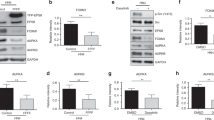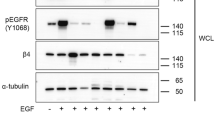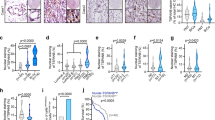Abstract
Epidermal growth factor receptor (EGFR) and Src tyrosine kinase cooperate in regulating EGFR-mediated cell signaling and promoting cell transformation and tumorigenesis in pathological conditions. Activation of Src is tightly regulated by the C-terminal Src kinase (Csk). The Csk-binding protein (Cbp) is a ubiquitously expressed transmembrane protein. Its functions include suppression of T-cell receptor activation through recruiting Csk and inhibiting Src family kinase (SFK). However, a potential role of Cbp in EGF-induced cell activities has not been investigated. Here, we report that EGF-stimulation-induced Cbp tyrosine phosphorylation followed by Cbp–Csk association, in a SFK-dependent manner. Expression of wild-type (wt) Cbp remarkably suppressed EGF-induced activation of Src, ERK1/2, and Akt-1 enzymes, and NIH3T3 cell transformation, as well as colony formation of a breast cancer cell line (MDA-MB-468) in soft agar. In contrast, expression of CbpY317F or knockdown endogenous Cbp in NIH3T3 cells by RNA interference significantly enhanced EGF-induced activation of these enzymes and cell transformation. In addition, overexpression of multiple receptor tyrosine kinases (RTKs)-induced Cbp tyrosine phosphorylation. These results demonstrate that Cbp functions as a negative regulator of cell transformation and tumor cell growth through downregulation of Src activation, suggesting that Cbp might be broadly involved in RTKs-activated signaling pathways and tumorigenesis.
This is a preview of subscription content, access via your institution
Access options
Subscribe to this journal
Receive 50 print issues and online access
$259.00 per year
only $5.18 per issue
Buy this article
- Purchase on Springer Link
- Instant access to full article PDF
Prices may be subject to local taxes which are calculated during checkout










Similar content being viewed by others
References
Baumeister U, Funke R, Ebnet K, Vorschmitt H, Koch S, Vestweber D . (2005). EMBO J 24: 1686–1695.
Baumgartner M, Angelisova P, Setterblad N, Mooney N, Werling D, Horejsi V et al. (2003). Blood 101: 1874–1881.
Biscardi JS, Belsches AP, Parsons SJ . (1998). Mol Carcinog 21: 261–272.
Biscardi JS, Maa MC, Tice DA, Cox ME, Leu TH, Parsons SJ . (1999). J Biol Chem 274: 8335–8343.
Bivona TG, Perez De Castro I, Ahearn IM, Grana TM, Chiu VK, Lockyer PJ et al. (2003). Nature 424: 694–698.
Brdicka T, Pavlistova D, Leo A, Bruyns E, Korinek V, Angelisova P et al. (2000). J Exp Med 191: 1591–1604.
Cance WG, Liu ET . (1995). Breast Cancer Res Treat 35: 105–114.
Cao H, Sanguinetti AR, Mastick CC . (2004). Exp Cell Res 294: 159–171.
Couet J, Li S, Okamoto T, Ikezu T, Lisanti MP . (1997). J Biol Chem 272: 6525–6533.
Davidson D, Bakinowski M, Thomas ML, Horejsi V, Veillette A . (2003). Mol Cell Biol 23: 2017–2028.
DeMali KA, Godwin SL, Soltoff SP, Kazlauskas A . (1999). Exp Cell Res 253: 271–279.
Di Fiore PP, Pierce JH, Fleming TP, Hazan R, Ullrich A, King CR et al. (1987). Cell 51: 1063–1070.
Dobenecker MW, Schmedt C, Okada M, Tarakhovsky A . (2005). Mol Cell Biol 25: 10533–10542.
Franke TF, Hornik CP, Segev L, Shostak GA, Sugimoto C . (2003). Oncogene 22: 8983–8998.
Ishizawar R, Parsons SJ . (2004). Cancer Cell 6: 209–214.
Ishizawar RC, Tice DA, Karaoli T, Parsons SJ . (2004). J Biol Chem 279: 23773–23781.
Jiang T, Qiu Y . (2003). J Biol Chem 278: 15789–15793.
Karni R, Jove R, Levitzki A . (1999). Oncogene 18: 4654–4662.
Kassenbrock CK, Hunter S, Garl P, Johnson GL, Anderson SM . (2002). J Biol Chem 277: 24967–24975.
Kawabuchi M, Satomi Y, Takao T, Shimonishi Y, Nada S, Nagai K et al. (2000). Nature 404: 999–1003.
Kharitonenkov A, Chen Z, Sures I, Wang H, Schilling J, Ullrich A . (1997). Nature 386: 181–186.
Kim YN, Dam P, Bertics PJ . (2002). Exp Cell Res 280: 134–147.
Kong M, Mounier C, Dumas V, Posner BI . (2003). J Biol Chem 278: 5837–5844.
Lev DC, Kim LS, Melnikova V, Ruiz M, Ananthaswamy HN, Price JE . (2004). Br J Cancer 91: 795–802.
Lisanti MP, Scherer PE, Vidugiriene J, Tang Z, Hermanowski-Vosatka A, Tu YH et al. (1994). J Cell Biol 126: 111–126.
Lu Y, Yu Q, Liu JH, Zhang J, Wang H, Koul D et al. (2003). J Biol Chem 278: 40057–40066.
Maa MC, Leu TH, McCarley DJ, Schatzman RC, Parsons SJ . (1995). Proc Natl Acad Sci USA 92: 6981–6985.
Mason CS, Springer CJ, Cooper RG, Superti-Furga G, Marshall CJ, Marais R . (1999). EMBO J 18: 2137–2148.
Matsuoka H, Nada S, Okada M . (2004). J Biol Chem 279: 5975–5983.
Nguyen DM, Schrump DS . (2004). Semin Thorac Cardiovasc Surg 16: 3–12.
Ohtake H, Ichikawa N, Okada M, Yamashita T . (2002). J Immunol 168: 2087–2090.
Okamoto T, Schlegel A, Scherer PE, Lisanti MP . (1998). J Biol Chem 273: 5419–5422.
Olayioye MA, Beuvink I, Horsch K, Daly JM, Hynes NE . (1999). J Biol Chem 274: 17209–17218.
Rae JM, Lippman ME . (2004). Breast Cancer Res Treat 83: 99–107.
Roche S, Koegl M, Barone MV, Roussel MF, Courtneidge SA . (1995). Mol Cell Biol 15: 1102–1109.
Shien T, Doihara H, Hara H, Takahashi H, Yoshitomi S, Taira N et al. (2004). Breast Cancer 11: 367–373.
Shima T, Nada S, Okada M . (2003). Proc Natl Acad Sci USA 100: 14897–14902.
Simons K, Ikonen E . (1997). Nature 387: 569–572.
Smart EJ, Ying YS, Mineo C, Anderson RG . (1995). Proc Natl Acad Sci USA 92: 10104–10108.
Song KS, Li S, Okamoto T, Quilliam LA, Sargiacomo M, Lisanti MP . (1996). J Biol Chem 271: 9690–9697.
Tremblay L, Hauck W, Aprikian AG, Begin LR, Chapdelaine A, Chevalier S . (1996). Int J Cancer 68: 164–171.
Tsuruda A, Suzuki S, Maekawa T, Oka S . (2004). FEBS Lett 560: 215–220.
Van Slyke P, Coll ML, Master Z, Kim H, Filmus J, Dumont DJ . (2005). Mol Cell Biol 25: 3831–3841.
Wang B, Lemay S, Tsai S, Veillette A . (2001). Mol Cell Biol 21: 1077–1088.
Wilson LK, Luttrell DK, Parsons JT, Parsons SJ . (1989). Mol Cell Biol 9: 1536–1544.
Xu S, Huo J, Tan JE, Lam KP . (2005). Mol Cell Biol 25: 8486–8495.
Yarden Y, Sliwkowski MX . (2001). Nat Rev Mol Cell Biol 2: 127–137.
Yayon A, Ma YS, Safran M, Klagsbrun M, Halaban R . (1997). Oncogene 14: 2999–3009.
Zhang SQ, Yang W, Kontaridis MI, Bivona TG, Wen G, Araki T et al. (2004). Mol Cell 13: 341–355.
Acknowledgements
We thank Dr Axel Ullrich for providing the plasmids and cell lines as mentioned in Materials and methods. This work was supported by the grants from National Natural Science Foundation of China (No. 30270335) and from the Ministry of Science and Technology, China (No. 2001AA233031 and No. 2001CB510205) and also from Shanghai-Anson Research Foundation (SHARF).
Author information
Authors and Affiliations
Corresponding author
Rights and permissions
About this article
Cite this article
Jiang, L., Feng, X., Zhou, W. et al. Csk-binding protein (Cbp) negatively regulates epidermal growth factor-induced cell transformation by controlling Src activation. Oncogene 25, 5495–5506 (2006). https://doi.org/10.1038/sj.onc.1209554
Received:
Revised:
Accepted:
Published:
Issue Date:
DOI: https://doi.org/10.1038/sj.onc.1209554
Keywords
This article is cited by
-
PAG - a multipurpose transmembrane adaptor protein
Oncogene (2014)
-
GRIM-19 mutations fail to inhibit v-Src-induced oncogenesis
Oncogene (2014)
-
Overexpression of Csk-binding protein contributes to renal cell carcinogenesis
Oncogene (2009)
-
Caveolin-1 in tumor progression: the good, the bad and the ugly
Cancer and Metastasis Reviews (2008)
-
Tyrosine phosphorylated Par3 regulates epithelial tight junction assembly promoted by EGFR signaling
The EMBO Journal (2006)



